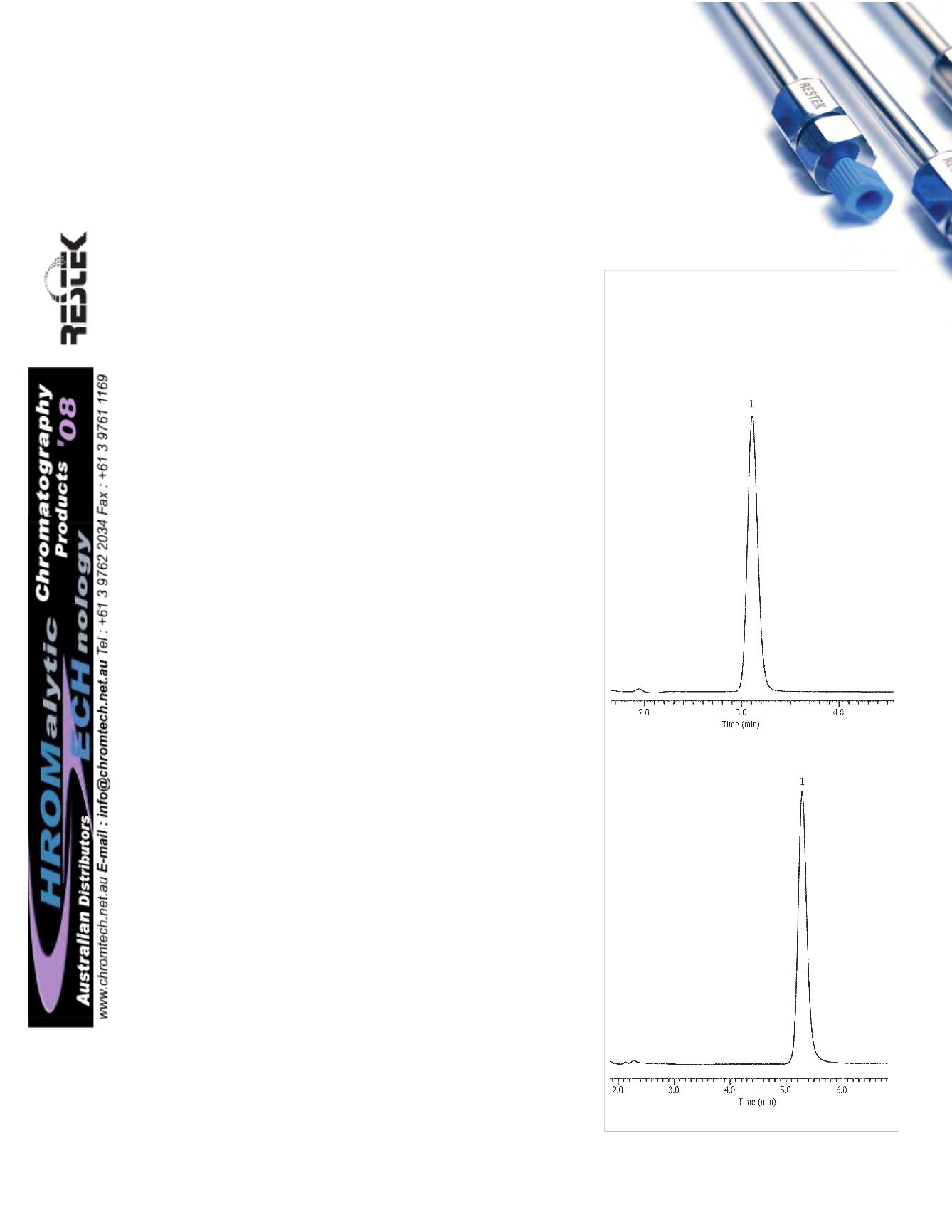

•
18
•
2008 vol. 1
Pharmaceutical
Reversed phase HPLC analyses are predominantly performed on C18
columns, which, in many cases, are suitable. There are, however, situations in
which a conventional C18 column produces less than optimal chromatogra-
phy. For example, C18 columns have little retention for hydrophilic com-
pounds, basic compounds often exhibit peak tailing, and highly aqueous con-
ditions can cause inconsistent retention or even phase collapse.
One way in which column manufacturers attempt to address these issues, and
yet maintain the favorable hydrophobic interaction of a C18 column, is to
impart polar functionality into an alkyl phase. The Ultra IBD column is an
example of such a polar embedded column. Compared to a C18 column, this
column offers enhanced retention and selectivity towards a wider range of
compounds, orthogonal separations, improved base-deactivation, and com-
patibility with entirely aqueous mobile phases.
Degree of Polarity
The Ultra IBD column exhibits a high degree of polarity relative to conven-
tional and aqueous C18 phases. Because the Ultra IBD column possesses both
nonpolar and highly polar characteristics, it can be used in both normal phase
mode and reversed phase mode. The bonding chemistry used in the Ultra IBD
column makes it a very adaptable column capable of unique separations.
Base-Deactivation
The Ultra IBD column bonding chemistry alleviates one of the common
problems associated with alkyl phases—peak tailing of basic analytes.
Comparing the analysis of amitriptyline on a conventional C18 column and
an Ultra IBD column demonstrates the effectiveness of this bonding chem-
istry. Amitriptyline is a highly basic, tricyclic antidepressant that commonly
tails on silica-based alkyl phases. Even at a neutral pH and, importantly, with
no modifiers, the Ultra IBD column exhibits excellent peak shape for
amitriptyline (Figure 1). This is advantageous because it provides needed flex-
ibility for method development, especially for analytes that are labile under
acidic conditions. In applications where Gaussian peak shape is needed for
accurate integrations, such as potency assays, or when tighter system suitabil-
ity criteria are required, an intrinsically base-deactivated stationary phase
offers a benefit that a conventional C18 column cannot—exceptional peak
shape with a simplified mobile phase.
Retention and Selectivity
In contrast to conventional C18 columns, the Ultra IBD has a polar functional
group embedded within the alkyl chain. Retention, therefore, is attributed not
only to hydrophobic interactions (the major retention mechanism of an alkyl
(or C18) phase, but also to polar attraction between the analyte and stationary
phase. This mixed-mode mechanism results in high retention for hydrophilic
compounds or compounds with polar moieties, such as purines (Figure 2).
Orthogonal separations also can be achieved through the Ultra IBD phase
chemistry. For example, a small group of hydroxybenzoic acids was also assayed
on a C18 and IBD column under identical conditions. The elution order of the
analytes differed and dihydroxybenzoic acid was more retained on the Ultra
IBD column (Figure 3). Additionally, the unique phase chemistry of the Ultra
IBD column makes it suitable for a simultaneous analysis of a wide range of
compounds—acidic through basic, as well as zwitterions (Figure 4).
Multi-task with an Ultra IBD Column
A Versatile Column with Many Applications
By Rick Lake, Pharmaceutical Innovations Chemist
• Effective in normal or reversed mode; compatible with 100% aqueous mobile phases.
• Excellent base deactivation—superior peak shape for basic compounds.
• Enhanced retention of hydrophilic compounds.
Figure 1
Ultra IBD offers more flexibility in
method development giving excellent
peak shape for highly basic compounds—
even without mobile phase modifiers—
over a wide mobile phase pH range.
Sample:
Inj.:
10µL
Conc.:
~100µg/mL
Sample diluent: mobile phase
Column:
Ultra IBD
Cat.#:
9175565
Dimensions: 150mm x 4.6mm
Particle size: 5µm
Pore size:
100Å
Conditions:
Mobile phase: 10:90 20mM
potassium phosphate
(pH 3):methanol
Flow:
1.0mL/min.
Temp.:
ambient
Det.:
UV @ 254nm
Peak List
1. amitriptyline
LC_PH0443
Mobile Phase pH 3
USP tailing 1.10
Mobile Phase pH 7
USP tailing 1.13
LC_PH0444











